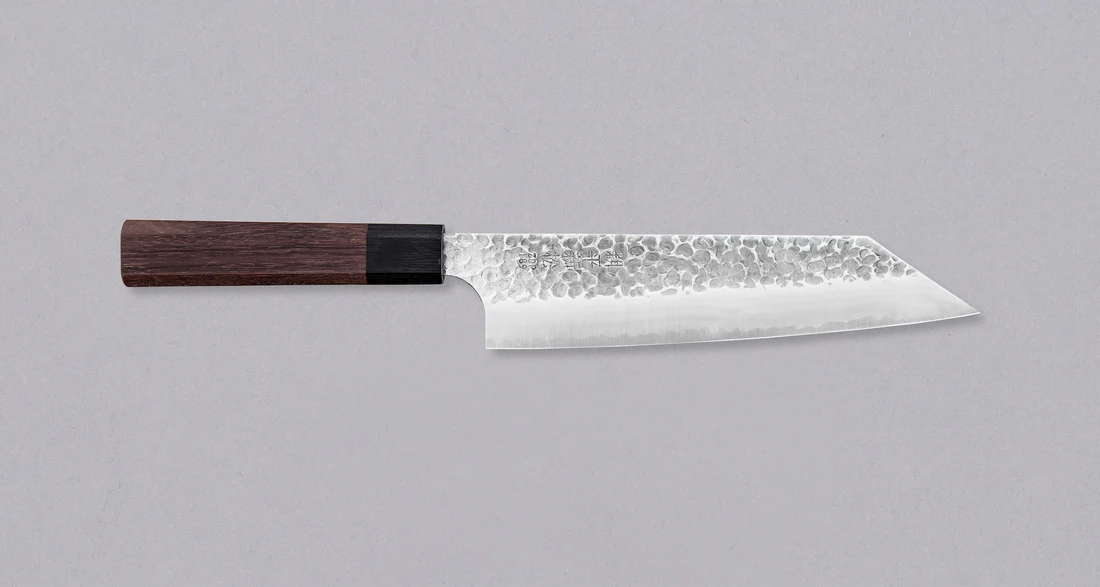Historical Context
The Bunka knife, or Bunka Bōchō, originated in post-war Japan in the mid-20th century. It was created as a response to the growing need for versatile and efficient kitchen tools suitable for modern home cooking. By merging traditional Japanese aesthetics with practical usability, the Bunka became a staple in many households.
The word “Bunka” means “culture” or “cultural,” a name that speaks to the knife’s symbolic role in modernizing cooking practices in Japanese kitchens. It bridged a gap between time-honored craftsmanship and the evolving culinary needs of everyday cooks.
Design Features
The most recognizable characteristic of this Japanese utility knife is its angular reverse tanto tip, also known as a “k-tip,” paired with a flat edge profile. This combination supports high-precision work such as fine slicing, scoring vegetables, and controlled chopping.
These knives usually range from 120mm to 180mm, with 165mm being a standard length. This sizing ensures they are nimble enough for delicate prep tasks, yet robust enough to handle more demanding jobs. The well-balanced construction allows for extended use without fatigue.
Their double-bevel edge, typically sharpened between 10 to 15 degrees, provides razor-sharp cutting performance suitable for both right- and left-handed users. This makes them one of the most approachable entries in the broader family of Japanese chef knives.
Craftsmanship
What makes these blades truly stand out is the level of craftsmanship involved in their production. High-performance steels like VG10 and SG2 are commonly used, offering an ideal mix of hardness, edge retention, and corrosion resistance.
They are often handcrafted in knife-making regions such as Seki and Takefu—areas steeped in centuries-old forging traditions. In these cities, skilled artisans continue to uphold techniques passed down through generations.
Among the most respected bladesmiths are Yu Kurosaki and Yoshimi Kato. Their work on this type of knife is renowned for exceptional edge geometry, stunning finish, and consistency in performance.
Practical Applications
Functionality is where this Japanese kitchen tool shines. Its shape allows for a wide range of culinary tasks: from slicing raw meat and trimming herbs to cutting hard root vegetables. The flat edge performs well on cutting boards, while the pointed tip excels in detail-oriented work.
The k-tip, in particular, is ideal for intricate techniques such as julienne or brunoise cuts. Chefs value this feature for delicate operations, making it an excellent choice for those requiring precision.
Although not as ubiquitous in professional kitchens as Santoku or Gyuto models, this angular-tipped knife is gaining recognition. Its hybrid nature—blending Western-style usability with Japanese refinement—positions it uniquely in the market.
Industry Perception
While still under the radar for some chefs, this lesser-known Japanese blade is appreciated by those who value its distinctiveness. Its ability to cover a range of cooking styles makes it ideal for professionals looking for a multifunctional yet elegant solution.
Market-wise, this knife is often seen as a midpoint between the more common Nakiri knives and chef’s knives. It attracts buyers seeking something different yet dependable—a tool that can become a permanent fixture in their kitchen lineup.
SharpEdgeShop as a Go-To Destination
For those exploring high-qualityJapanese chef knives, SharpEdgeShop offers a curated selection that includes many outstandingBunka knives. Each blade is chosen not just for its performance but also for its craftsmanship, design, and materials.
SharpEdgeShop stands apart in its dedication to educating cooks on the importance of good knives.
Their philosophy centers on helping customers achieve Jinba Ittai (人馬一體)—a concept where the user and the tool become one. They believe that the right knife isn’t just a kitchen tool, but an extension of your body. Better knife control leads to more precision, which directly improves the quality of food.
Whether you’re a professional chef or a culinary hobbyist, finding the right knife is critical. With options that range from this versatile blade toNakiri knives, the platform provides blades to suit every kitchen scenario.
Conclusion
This reverse-tanto kitchen knife combines tradition with innovation. With its striking design, balanced build, and unmatched utility, it deserves recognition beyond specialist circles. Its unique features and history make it a knife worth exploring, particularly for those who value both function and form in their kitchen tools.
For those ready to upgrade their kitchen arsenal, exploring Bunka knives through SharpEdgeShop is a smart starting point. Their commitment to quality and education makes them a trusted source for knives that stand the test of time.

Leave a Reply